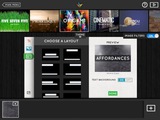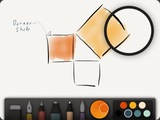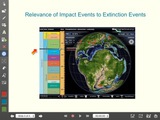
An interesting phenomenon that has accompanied the rise of mobile devices is a rethinking and revitalized exploration of key elements of human interface design. Many people have misread this as a "dumbing down" of apps, due to the lower availability of computational power on smartphones and tablets; this is definitely not the case. An iPad today is as powerful as the computers I ran Final Cut Pro, Photoshop, and Mathematica on not that long ago. Given this, the real question is not what can an app do, but rather what should it do. It is easy to avoid tough decisions about what features to include on desktop and laptop machines - just keep on doing what you've been doing all along, even if it never worked all that well to begin with. The new opportunities and usage environments afforded by mobile devices mean that making the same choices will at best miss possibilities for leaps forward, at worst seriously interfere with the usability of the device. Navigating endless hierarchical menus plus associated dialog boxes is already a waste of time on traditional devices; on mobile devices it becomes an impossible task.
Fortunately, several developers have risen to the challenge of carefully selecting the 80% of features that are crucial to the execution of a task, then framing them in the context of an interface that makes them accessible and evident. Automation of secondary aspects of a task also plays a key role here: we gain little from our use of technology if digital busywork replaces its paper counterpart. Those of us that work in education can learn from studying these new approaches, including the fact that many of these apps stress elegant design and enjoyable experiences. If we want our students to create more frequently and across a wider range of disciplines with mobile devices than they have with more traditional computing tools - and I would strongly argue that this should be one of our goals - then providing them tools that are a pleasure to use is a key component of this strategy. Here are three apps that exemplify particular approaches - with apologies to Brian Eno, I'll refer to each as a variation on Taking Tiger Mountain (By Strategy):
Taking Mobile Mountain (By Simplicity)
 Far too many traditional software tools are laden with features that only 20% of the users will need 20% of the time, making the crucial feature set hard to find, needlessly complex, and slow to use. By contrast, focusing on a minimal feature set that 80% of the users will want 80% of the time, and automating the rest, can lead to agile and powerful results. Haiku Deck exemplifies this beautifully in the presentation software domain. Your task is to focus on the content you wish to convey and the images that will best illustrate it - and Haiku Deck takes care of the rest. Would you like to set pages and pages of text on a single slide in 6-point Comic Sans, just so you can see your audience weep? Sorry - you'll have to look elsewhere - Haiku Deck's design smarts won't allow that. On the other hand, would you like to have Creative Commons images easily located for illustration, with authorship credited properly and automatically? Haiku Deck will happily handle this. It is important to distinguish this approach from the "wizards" found in many traditional apps (see the late and not-so-lamented Clippy for an example): the latter are a half-hearted attempt to cover up complexity with inadequate default options.
Far too many traditional software tools are laden with features that only 20% of the users will need 20% of the time, making the crucial feature set hard to find, needlessly complex, and slow to use. By contrast, focusing on a minimal feature set that 80% of the users will want 80% of the time, and automating the rest, can lead to agile and powerful results. Haiku Deck exemplifies this beautifully in the presentation software domain. Your task is to focus on the content you wish to convey and the images that will best illustrate it - and Haiku Deck takes care of the rest. Would you like to set pages and pages of text on a single slide in 6-point Comic Sans, just so you can see your audience weep? Sorry - you'll have to look elsewhere - Haiku Deck's design smarts won't allow that. On the other hand, would you like to have Creative Commons images easily located for illustration, with authorship credited properly and automatically? Haiku Deck will happily handle this. It is important to distinguish this approach from the "wizards" found in many traditional apps (see the late and not-so-lamented Clippy for an example): the latter are a half-hearted attempt to cover up complexity with inadequate default options.
Also see: iA Writer, an app that focuses on the barebones essentials that writers need for their craft - it's what I use to write these blog posts (and pretty much everything else) these days.
Taking Mobile Mountain (By Abstraction)
 Another approach is to focus on the idea behind the toolset for a task you might want to accomplish, and abstract its key features, distilling it into a conceptually refined form. Painting and drawing apps are popular on the iPad, and many of them take an approach to natural media simulation that is derived from Painter, the granddaddy of the field. These apps provide a huge set of parameters for tweaking media, brush, and canvas simulations, controlled by correspondingly large numbers of palettes, sliders, and choosers. But what if you instead took a step back, and tried to create an idealized pen, watercolor wash, marker, etc. with a single set of settings and likewise idealized behaviors? The result would be akin to Paper by FiftyThree. No watercolor brush ever behaved like the one in Paper - but the idea of a watercolor brush might. The color mixer in Paper does not model realistically what would happen in a physical paint pot - but it does correspond to a logical abstraction from the process that is also very different from a traditional color picker. The programming team has added features very slowly to Paper - a magnifying loupe only made it into the app after it had been out for over a year - but each feature is carefully crafted to retain the overall approach and balance.
Another approach is to focus on the idea behind the toolset for a task you might want to accomplish, and abstract its key features, distilling it into a conceptually refined form. Painting and drawing apps are popular on the iPad, and many of them take an approach to natural media simulation that is derived from Painter, the granddaddy of the field. These apps provide a huge set of parameters for tweaking media, brush, and canvas simulations, controlled by correspondingly large numbers of palettes, sliders, and choosers. But what if you instead took a step back, and tried to create an idealized pen, watercolor wash, marker, etc. with a single set of settings and likewise idealized behaviors? The result would be akin to Paper by FiftyThree. No watercolor brush ever behaved like the one in Paper - but the idea of a watercolor brush might. The color mixer in Paper does not model realistically what would happen in a physical paint pot - but it does correspond to a logical abstraction from the process that is also very different from a traditional color picker. The programming team has added features very slowly to Paper - a magnifying loupe only made it into the app after it had been out for over a year - but each feature is carefully crafted to retain the overall approach and balance.
Also see: GarageBand - it was good on desktops and laptops, and adding touch to it made it even better. Again, no physical instrument ever behaved quite like this - but watch your students play with it, and understand some fundamentals of music faster than they ever did before.
Taking Mobile Mountain (By Dense Focus)
 A third option is to pack an application densely with every feature you could want to accomplish a well defined task - and no more. For instance, suppose you or your students wished to produce videos à la Khan Academy, but with greater ease and visual flair. Make a list of all the features that you would need for this specific task, and how you would use them. Odds are very good that your list would be a close match to the feature set of Explain Everything. This is not a coincidence: the app programming team has been particularly responsive to feedback provided by users (including, as related by Jennie Magiera, 4th grade students), and has used this information intelligently. The app is finely tuned to mobile use, and rich with targeted features, which make it much more than a simple copycat of traditional presentation or screencasting software.
A third option is to pack an application densely with every feature you could want to accomplish a well defined task - and no more. For instance, suppose you or your students wished to produce videos à la Khan Academy, but with greater ease and visual flair. Make a list of all the features that you would need for this specific task, and how you would use them. Odds are very good that your list would be a close match to the feature set of Explain Everything. This is not a coincidence: the app programming team has been particularly responsive to feedback provided by users (including, as related by Jennie Magiera, 4th grade students), and has used this information intelligently. The app is finely tuned to mobile use, and rich with targeted features, which make it much more than a simple copycat of traditional presentation or screencasting software.
For another example of this approach, see: iSpartan, a tool for molecular modeling that competes well with most of its desktop peers - and is a lot more fun to use.
It is important to realize that not all worthwhile apps need follow one of these approaches. For instance, in my own work I also use the iWork suite, which is designed along traditional office suite lines, but has an interface that is nicely adapted for mobile use; Autodesk SketchBook Pro, which implements a complex and highly customizable approach to natural media sketching; and Korg's iPolysix synthesizer, which lovingly recreates every detail of its physical counterpart. I would have no problem recommending any of these more traditional apps for use by schools - but I also think we do our students a disservice if we do not weigh how new apps, with new mobile-optimized approaches can introduce new workflows that are better suited to achieving new and ambitious educational goals.
Posted by Ruben at May 27, 2013 7:50 PM | TrackBack